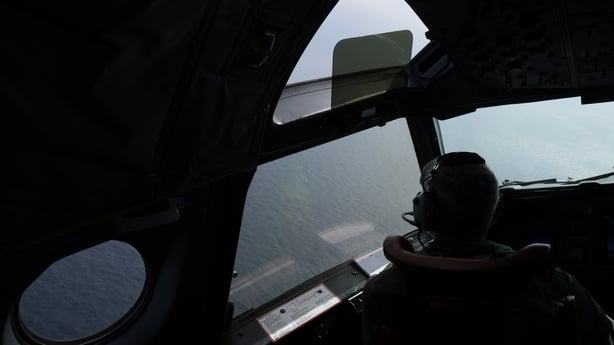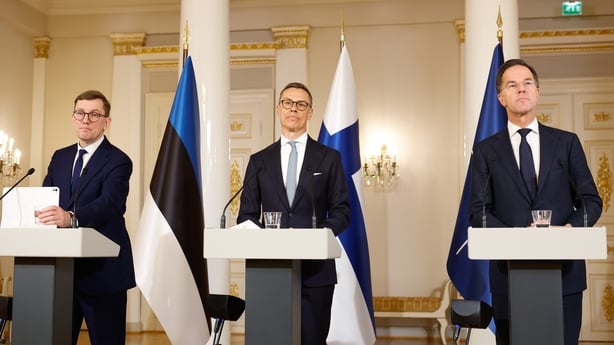This week NATO Secretary-General Mark Rutte announced that the military alliance would launch a new exercise in the Baltic Sea in response to the latest cable cutting incidents in December.
'Baltic Sentry' will involve frigates, maritime aircraft and a fleet of drones to respond to, what NATO calls, "destabilising acts".
NATO suspects Russia was behind the incidents and is calling it sabotage, allegations that the Kremlin has denied.
What we know is this: on Christmas Day, one power cable and four telecommunications cables linking Estonia and Finland in the Baltic Sea were damaged.
A section of the Estlink-2 power cable, operated by Fingrid, the Finnish national grid operator, was cut at around noon that day.
It had a transmission capacity of 650 megawatts - about two-thirds of the electricity transmitted between the two countries - and is still out of action.
Estlink-1, with a smaller capacity, continues to transmit power between Finland and Estonia.
Telecommunications cables were damaged later in the day, including two operated by Elisa, a Finnish telecom company.
"Between 6 and 7pm, we found from our monitoring that there was a problem with the international connection systems," Jaakko Wallenius, Elisa's Vice President and Chief Security Officer told RTÉ News.
"When they were repairing the cables, the damage resembled when an anchor is dragged on a cable," said Mr Wallenius.

Telecom services didn’t go down because Elisa runs other backup routes for its international connections.
The next day, the Eagle-S, an oil tanker suspected of carrying out the damage, was boarded by Finnish special forces once it entered Finnish territorial waters and detained.
Registered in the Cook Islands but owned by a company in the United Arab Emirates, the ship was transporting Russian oil.
The Eagle-S is believed to be part of Russia’s "shadow fleet", a catch-all term for international ships that transport Russian crude oil around the world as a way for Russia to evade the West’s sanctions on the commodity.
The Kyiv School of Economics estimates that just under 200 ships make up the fleet with Panama, Liberia and Gabon listed as the three most common flags under which the ships sail.
Other cable cutting incidents have occurred in the Baltic during the past two years.
In November, Swedish authorities suspected a Chinese ship of cutting two telecoms cables linking Finland and Germany, as well as Lithuania and Sweden.
In October 2023, a gas pipeline between Finland and Estonia was cut by another Chinese ship, the Newnew Polar Bear. A telecoms cable was also cut around the same time. A month later, two more telecoms cables, one between Sweden and Lithuania and another linking Finland and Germany were cut.
More dramatically, in September 2022, two Nordstream gas pipelines were blown up close to the Danish island of Bornholm. It is still unclear who carried out the audacious attack.
Ukraine has blamed Russia while a Wall Street Journal report last year said a privately-funded Ukrainian group organised the operation.
"Before the full-scale invasion of Ukraine nobody was talking about sabotage, it was being called an accident," Mariusz Marszałkowski, a Polish security analyst at news site Defence24, told RTÉ News.
"But, if we take all these accidents, we see that there are similarities. They were all related to energy and critical infrastructure," said Mr Marszałkowski.

Russia, he said, is unable to conduct a full-scale war against countries in the Baltic Sea region but wants to show the West that it can instead use unconventional warfare.
Unconventional warfare, or "hybrid warfare" is a term used frequently by leaders along NATO’s eastern flank to describe suspected Russian intelligence operations in their countries.
It can encompass disinformation campaigns, cyber-attacks, assassination attempts and sabotage.
"Hybrid means sabotage," Mr Rutte told reporters in Helsinki earlier this week after a summit with leaders from the eight NATO countries in the Baltic Sea region.
The cable cutting incidents will be a wake-up call for other countries in the region to reassess the security of pipelines and telecoms cables that they use.
Take Poland, for instance. The country gets more than half of its annual gas supply from Norway via a pipeline that goes through Danish waters.
A sabotage operation against that pipeline would reduce Poland’s gas imports by half.
The Polish and German navies have been underfunded in recent decades and are only now taking the task of modernising seriously, whereas three Baltic States each operate small navies.
Sweden, like Germany, has a handful of submarines which will be useful, while Finland has a small but well-equipment navy. More than likely, other NATO members will play a role in the patrol mission.

and Mark Rutte, Secretary-General of NATO speaking in Helsinki this week
NATO has "moved at a snail's pace" to react to incidents in the Baltic Sea, said Glen Grant, a retired British army officer, now a senior expert for the Baltic Security Foundation in Riga.
Russia, he believes does not want a real confrontation but wants to "degrade and destroy without causing military activity," Mr Grant told RTÉ News.
Ireland is not isolated from the activities of covert Russian ships. Only last November, a suspected Russian spy ship was monitored by the Irish Naval Service operating near subsea internet and energy cables in the Irish Sea.
An Irish Naval Service vessel prevented the ship from entering Ireland's maritime Exclusive Economic Zone.
And just weeks before Russia invaded Ukraine, coordinated action by Irish fishermen managed to get the Russian navy to move a live-fire exercise it had planned off the south-west coast of Ireland.
The fishermen continued to fish the same waters where the naval exercise was due to take place.
But the Baltic Sea is likely to continue to be Russia's most strategically important route.
Most of Russia's oil and gas infrastructure connects to ports in the west of the country, providing a gateway to export sanctioned fuel for much-needed revenues.
NATO's efforts to prevent future attacks on critical infrastructure will face the challenge of having to patrol such a large area.
A Finnish newspaper this week reported that about 10 ships would take part in the new NATO mission in the Baltic. They will have to patrol an area where it is estimated that approximately 2,000 ships are sailing at any given time, providing a challenging ratio.
Mr Marszałkowski described 'Baltic Sentry' as "a show of force for Russia" but said that patrolling the sea constantly would be costly for the participating countries.
"You cannot conduct constant sea operations."







